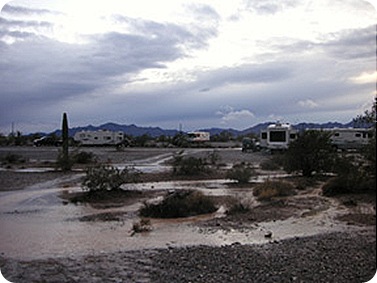
Dry wash running fast


Here are some pictures of the sky after the storm. It was different depending on which direction we looked.


But this morning we were again met with a glorious sunrise.

We drove 90 minutes down to Yuma, AZ today looking at possible campsites for our next stop. All the campgrounds are booked solid. We have to call them the first of next week to see if anyone checks out. If nothing opens up, we will head to Laughlin, NV instead. Have to wait and see.
On the way there we drove through the Yuma Proving Grounds.

They use this area to test military weapons, etc... We saw a giant balloon. What the heck is that used for??? It was located at a site called the USAF Aerostat Site.

We found out that it is a tethered Aerostat Radar System used by the US Air Force.
The Tethered Aerostat Radar System is a balloon-borne radar. The primary aerostat mission is to provide radar data in support of other federal agencies involved in the nation's drug interdiction program. The purpose is to seal off the border to illegal drugs coming in by aircraft. The program has been expanded to interdict the narcotic flow before it gets to the U.S. border.
The Federal Aviation Administration first advised Customs to begin looking for aerostat sites on the Southwest border and the gulf in 1981. Major General Piotrowski, in hearings before the House in 1983, urged consideration of the use of aerostats in the war on drugs. The requirement for the Tethered Aerostat Radar System network was established in 1984 by the U.S. Customs Service to help counter illegal drug trafficking. The first antidrug aerostat went operational in 1985 at High Rock Grand Bahama Island. The second site was built at Fort Huachuca, Ariz., in 1986. Intelligence sources reported dramatic decreases in the amount of airborne drug traffic since the first Southwest border antidrug balloon went up above Fort Huachuca, AZ, in 1987.
But aerostat balloons are not perfect. Weather, terrain, and other factors affect the performance of the aerostats. They have proven to be a fair weather friend. They must be brought to ground in high winds. Significant problems have plagued the contractor trying to get the bugs out of the aerostats plan for the Texas border. The radar planes are expensive to operate, but they can plug the holes in the aerostat net, if and when the planes are available.
The aerostat is a large fabric envelope filled with helium. It can rise up to 15,000 feet while tethered by a single cable, which has a maximum breaking strength of 26,000 pounds. For security and safety reasons, the air space around Air Force aerostats is restricted for a radius of at least two statute miles and an altitude up to 15,000 feet. The aerostat network consists of three sizes of aerostats and three varieties of radar. The smallest aerostat is about twice the size of the Goodyear Blimp. The 275,000 cubic foot, aerodynamically shaped balloon measures 175 feet long by 58 feet across the hull, with a tip-to-tip tail span of 81 feet. The aerostat system lifts a 1,200 pound payload to operating altitude for low-level radar coverage.
Hmmmm For more information visit the U.S. Air Force site.
Yuma is a large fruit and vegetable growing area. Strange to see these green fields of lettuce and other vegetables growing in the desert. We saw many orange and lemon tree groves. All this is made possible by irrigation channels rerouting water from the Gila Bend River to their fields.
Their are fields after fields of lettuce and cabbage. We took this picture while driving 60 mph. Excuse the blurriness, please.

Irrigation

We have heard of just about every reason to celebrate but have never heard of the Lettuce Festival. On January 25, 26 and 27, Yuma…'The Winter Lettuce Capital of the World'….will hold its “12th Annual Yuma Lettuce Festival.” Their theme this year is "Cooking Up A Better Community.”
FROM THE WEBSITE: This event provides non-profit organizations the opportunity to sell a food, beverage or other item as a fundraiser. After paying your initial registration fee, all money raised belongs to your organization. We ask a non-profit to "partner" with a business or entity that supports Yuma's agriculture community and together create an item that includes at least 2 Yuma grown products. When selling the item, you will also be handing the consumer a recipe card (created by Heritage Festivals) that will list your ingredients, a "fact" about the products and information about the non-profit and the business partner. Consumers collect these cards at various booths, we add a "Recipe Box" cover and they take home their very own Yuma cookbook.
Historic Downtown Yuma is in the midst of the growing season. Although the high yields of lettuce grown in the Yuma area is mind boggling, the winter vegetable crops are just as amazing! Over 90 percent of the country's winter vegetable crops are grown in this area! Lettuce leads the way as the number one producing crop grown in the Yuma area.
With a purchase of produce from The Yuma Community Food Bank, or buy a salad at the Largest Southwest Salad Bar, each person will get a seed packet. Their are also fee Agriculture fields bus tours.
To read more about this neat celebration, click on the word Lettuce.
Back at “Q” I took the satellite dome that we took off our roof into the consignment shop in town. Hope to get a few bucks for it.
Had some dinner and chilled out the remainder of the afternoon.
Had a nice campfire tonight. Smaller group, but enjoyed each other's company.

What a way to end a day…..

Thanks for stopping by. Safe Travels!
